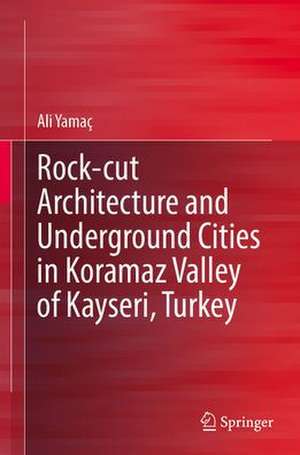Rock-cut Architecture and Underground Cities in Koramaz Valley of Kayseri, Turkey
Autor Ali Yamaçen Limba Engleză Hardback – 29 mar 2023
The book studies cliff settlements, rock-cut churches, underground cities, and funerary architecture in the valley. These shelters are estimated to have been built between the 7th and 10th centuries and even the smallest of these structures offer rich details for architectural, socio-cultural and historical studies. The rock-cut churches date to the Byzantine Empire period and during the research period, over 400 of these structures were explored, surveyed, and mapped in the region and with all these historical and natural values. Recently, the Koramaz Valley was accepted to the UNESCO World Heritage tentative list. This book is of interest to archaeologists and scholars of built heritage.
Preț: 697.32 lei
Preț vechi: 820.38 lei
-15% Nou
Puncte Express: 1046
Preț estimativ în valută:
133.43€ • 139.31$ • 110.43£
133.43€ • 139.31$ • 110.43£
Carte tipărită la comandă
Livrare economică 04-18 aprilie
Preluare comenzi: 021 569.72.76
Specificații
ISBN-13: 9783031293733
ISBN-10: 3031293738
Pagini: 168
Ilustrații: IX, 168 p. 65 illus. in color.
Dimensiuni: 155 x 235 mm
Greutate: 0.43 kg
Ediția:2023
Editura: Springer International Publishing
Colecția Springer
Locul publicării:Cham, Switzerland
ISBN-10: 3031293738
Pagini: 168
Ilustrații: IX, 168 p. 65 illus. in color.
Dimensiuni: 155 x 235 mm
Greutate: 0.43 kg
Ediția:2023
Editura: Springer International Publishing
Colecția Springer
Locul publicării:Cham, Switzerland
Cuprins
Introduction.- General Information.- Cliff Settlements of Koramaz Valley.- Rock-cut Churches of Koramaz Valley.- Underground Cities of Koramaz Valley.- Funerary Architecture of Koramaz Valley.- Conclusion.
Notă biografică
Ali Yamaç is a Turkish speleologist. He was born in 1957 and caving since 1976. In addition to his natural cave explorations, as a part of his artificial cave projects, he had explored and surveyed numerous underground cities and rock dwelled settlements around different regions of Turkey. He was the leader of the teams working for “Kayseri Underground Structures Inventory Project” and “Gaziantep Underground Structures Inventory Project”. He had explored, surveyed and mapped hundreds of artificial underground structures within these and other projects. Among them, there are 52 rock-cut Byzantine churches and 48 underground cities.
Textul de pe ultima copertă
In this book, rock-cut and underground structures of Koramaz Valley on the Anatolian Plateau in Turkey are described in detail. The valley; located in eastern Turkey near the town of Kayseri, has hundreds of rock-cut structures, in addition to several underground cities, and almost none of them have been studied before. Research conducted by a team from 2014 to 2020, resulted in this overview of all the rock-cut and underground structures in and around seven different settlements in the valley and aims for the physical documentation and inventory of all these structures.
The book studies cliff settlements, rock-cut churches, underground cities, and funerary architecture in the valley. These shelters are estimated to have been built between the 7th and 10th centuries and even the smallest of these structures offer rich details for architectural, socio-cultural and historical studies. The rock-cut churches date to the Byzantine Empire period and during the research period, over 400 of these structures were explored, surveyed, and mapped in the region and with all these historical and natural values. Recently, the Koramaz Valley was accepted to the UNESCO World Heritage tentative list. This book is of interest to archaeologists and scholars of built heritage.
Caracteristici
Presents newly found rock-cut Byzantine churches Studies hundreds of previously unknown cliff dwellings and several underground cities Offers new architectural, socio-cultural and historical insights into rock-cut architecture and underground cities
